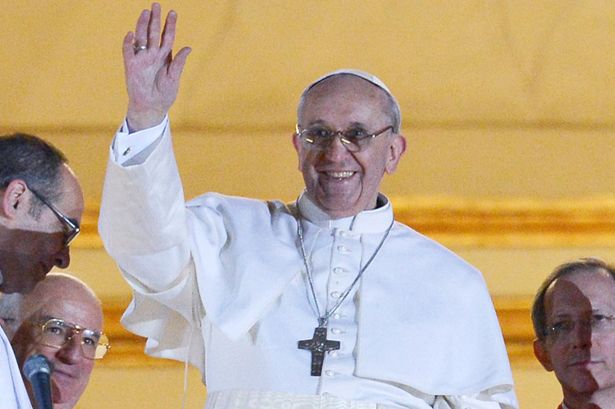His first day
Pope Francis began his first full day as pope with an early morning act of Marian devotion — and by paying the bill at the clergy hotel where he had stayed before entering the conclave that elected him. The new pope left the Domus Sanctae Marthae at 8 a.m. March 14 for a five-minute drive to the Basilica of St. Mary Major, where he prayed before an icon of Mary and the child Jesus beloved by Romans, the “Salus Populi Romani” (Protectress of the Roman People). Pope Francis knelt in prayer for a while, then sat praying for several minutes before leaving at the altar the bouquet of flowers he had been carrying, said Jesuit Father Federico Lombardi, Vatican spokesman. The pope was joined by Cardinal Agostino Vallini, papal vicar for Rome. Pope Francis, a Jesuit, then went to the Sistine Chapel of the Basilica of St. Mary Major, which is where St. Ignatius of Loyola celebrated his first Mass in 1538.
Amongst first appointments
The Mass for the installation of a new pope will be celebrated March 19, the solemnity of St. Joseph, patron of the universal church. The new pope will recite the Angelus March 17 with visitors gathered in St. Peter’s Square. In the coming days he will also visit Pope emeritus in Castelgandolfo.
Who is the new Pope?
Argentine Cardinal Jorge Mario Bergoglio, 76, the leader of a large urban archdiocese in Latin America, was elected the 266th pope and took the name Francis. He is the first pope in history to come from the Western Hemisphere and the first non-European to be elected in almost 1,300 years. The Jesuit was also the first member of his order to be elected pope, and the first member of any religious order to be elected in nearly two centuries. The election March 13 came on the second day of the conclave, on the conclave’s fifth ballot. It was a surprisingly quick conclusion to a conclave that began with many plausible candidates and no clear favorite. The new pope was chosen by at least two-thirds of the 115 cardinals from 48 countries, who cast their ballots in secret in the Sistine Chapel. His election was announced in Latin from the balcony of St. Peter’s Basilica, to a massive crowd under the rain in the square below and millions watching around the world. White smoke poured from the Sistine Chapel chimney at 7:05 p.m., signaling that the cardinals had chosen a successor to retired Pope Benedict XVI. Two minutes later, the bells of St. Peter’s Basilica began pealing continuously to confirm the election. At 8:12, French Cardinal Jean-Louis Tauran, the senior cardinal in the order of deacons, appeared at the basilica balcony and read out in Latin: “I announce to you a great joy: We have a pope! The most eminent and most reverend lord, Lord Jorge Mario, Cardinal of the Holy Roman Church, Bergoglio, who has taken for himself the name Francis.”
Latin Americans about the Pope
Latin Americans said the election of the first pope from the region is recognition of the role the global South plays in the church’s future. Pope Francis I, the 76-year-old Argentine who served as archbishop of Buenos Aires as Cardinal Jorge Mario Bergoglio, comes as both a surprise and a source of hope for Latin American Catholics. “This is the news of the century. This is a moment of happiness for all of us,” Archbishop Oscar Vian Morales of Guatemala City told a news conference March 13. “We have received the news with great joy.” Pope Francis, who reportedly finished second in the conclave that elected Pope Benedict XVI in 2005, has long advocated for a better life for Argentina’s poor, carrying a message of social justice that resonates in a region where roughly three in 10 people are poor. “We’re very happy. … This is a man who has always represented the interests of the impoverished,” said Jesuit Father Jesus M. Sariego, representative of the Jesuit mission in Central America, based in El Salvador. “In terms of what this represents in the world, this is a signal of the importance and support” for our work. While church participation wanes in areas of the world where it had long flourished, such as Europe, Latin America is home to nearly 40 percent of the world’s Catholics, and Africa is the church’s fastest-growing region. “The global South is where the church should focus,” Father Sariego said. Although millions of Latin American Catholics have defected to evangelical sects or secularism, more than 70 percent remain Catholic.





